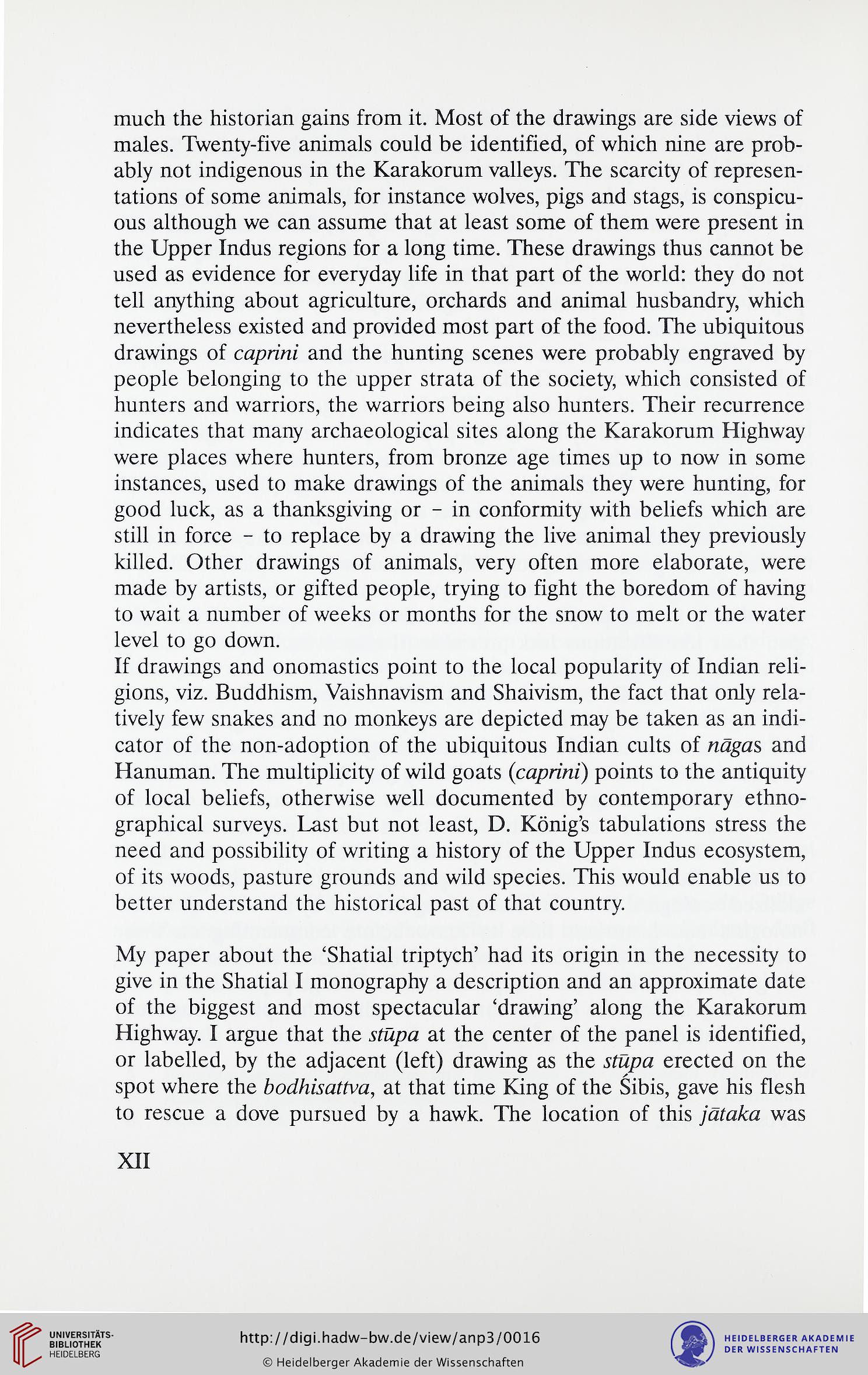much the historian gains from it. Most of the drawings are side views of
males. Twenty-five animals could be identified, of which nine are prob-
ably not indigenous in the Karakorum valleys. The scarcity of represen-
tations of some animals, for instance wolves, pigs and stags, is conspicu-
ous although we can assume that at least some of them were present in
the Upper Indus regions for a long time. These drawings thus cannot be
used as evidence for everyday life in that part of the world: they do not
tell anything about agriculture, orchards and animal husbandry, which
nevertheless existed and provided most part of the food. The ubiquitous
drawings of c<3przm and the hunting scenes were probably engraved by
people belonging to the upper strata of the society, which consisted of
hunters and warriors, the warriors being also hunters. Their recurrence
indicates that many archaeological sites along the Karakorum Highway
were places where hunters, from bronze age times up to now in some
instances, used to make drawings of the animals they were hunting, for
good luck, as a thanksgiving or - in conformity with beliefs which are
still in force - to replace by a drawing the live animal they previously
killed. Other drawings of animals, very often more elaborate, were
made by artists, or gifted people, trying to fight the boredom of having
to wait a number of weeks or months for the snow to melt or the water
level to go down.
If drawings and onomastics point to the local popularity of Indian reli-
gions, viz. Buddhism, Vaishnavism and Shaivism, the fact that only rela-
tively few snakes and no monkeys are depicted may be taken as an indi-
cator of the non-adoption of the ubiquitous Indian cults of rmgas and
Hanuman. The multiplicity of wild goats (cqpwn) points to the antiquity
of local beliefs, otherwise well documented by contemporary ethno-
graphical surveys. Last but not least, D. Konig's tabulations stress the
need and possibility of writing a history of the Upper Indus ecosystem,
of its woods, pasture grounds and wild species. This would enable us to
better understand the historical past of that country.
My paper about the 'Shatial triptych' had its origin in the necessity to
give in the Shatial I monography a description and an approximate date
of the biggest and most spectacular 'drawing' along the Karakorum
Highway. I argue that the .sfnpa at the center of the panel is identified,
or labelled, by the adjacent (left) drawing as the erected on the
spot where the boJ/tMaffva, at that time King of the Sibis, gave his flesh
to rescue a dove pursued by a hawk. The location of this was
XII
males. Twenty-five animals could be identified, of which nine are prob-
ably not indigenous in the Karakorum valleys. The scarcity of represen-
tations of some animals, for instance wolves, pigs and stags, is conspicu-
ous although we can assume that at least some of them were present in
the Upper Indus regions for a long time. These drawings thus cannot be
used as evidence for everyday life in that part of the world: they do not
tell anything about agriculture, orchards and animal husbandry, which
nevertheless existed and provided most part of the food. The ubiquitous
drawings of c<3przm and the hunting scenes were probably engraved by
people belonging to the upper strata of the society, which consisted of
hunters and warriors, the warriors being also hunters. Their recurrence
indicates that many archaeological sites along the Karakorum Highway
were places where hunters, from bronze age times up to now in some
instances, used to make drawings of the animals they were hunting, for
good luck, as a thanksgiving or - in conformity with beliefs which are
still in force - to replace by a drawing the live animal they previously
killed. Other drawings of animals, very often more elaborate, were
made by artists, or gifted people, trying to fight the boredom of having
to wait a number of weeks or months for the snow to melt or the water
level to go down.
If drawings and onomastics point to the local popularity of Indian reli-
gions, viz. Buddhism, Vaishnavism and Shaivism, the fact that only rela-
tively few snakes and no monkeys are depicted may be taken as an indi-
cator of the non-adoption of the ubiquitous Indian cults of rmgas and
Hanuman. The multiplicity of wild goats (cqpwn) points to the antiquity
of local beliefs, otherwise well documented by contemporary ethno-
graphical surveys. Last but not least, D. Konig's tabulations stress the
need and possibility of writing a history of the Upper Indus ecosystem,
of its woods, pasture grounds and wild species. This would enable us to
better understand the historical past of that country.
My paper about the 'Shatial triptych' had its origin in the necessity to
give in the Shatial I monography a description and an approximate date
of the biggest and most spectacular 'drawing' along the Karakorum
Highway. I argue that the .sfnpa at the center of the panel is identified,
or labelled, by the adjacent (left) drawing as the erected on the
spot where the boJ/tMaffva, at that time King of the Sibis, gave his flesh
to rescue a dove pursued by a hawk. The location of this was
XII




